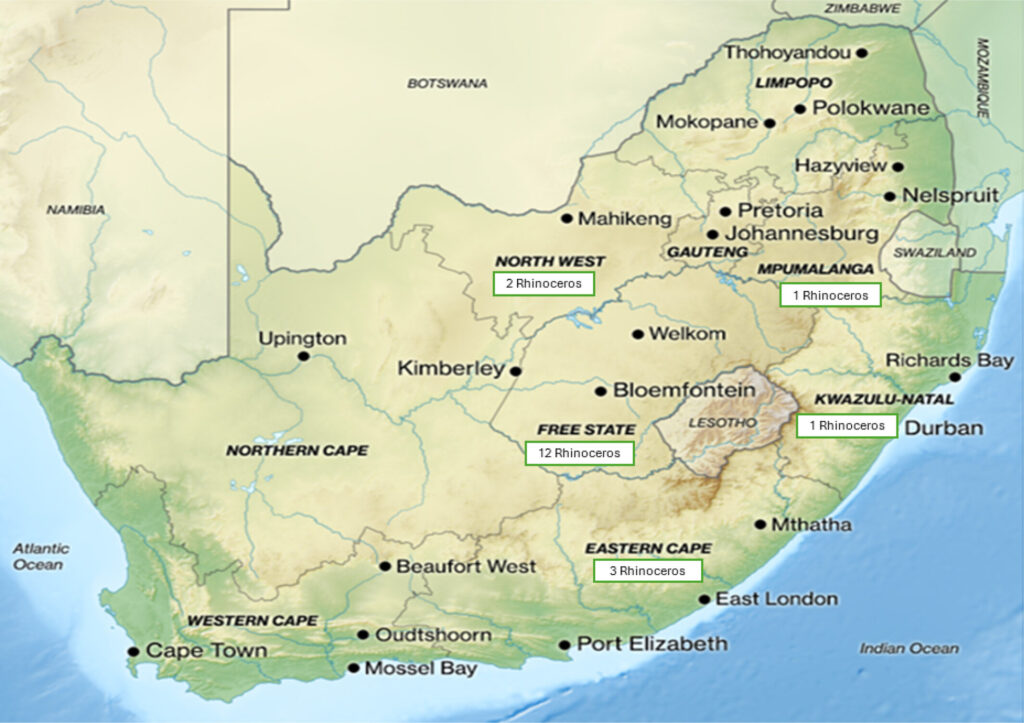Post-mortem interval determinations using insects collected from illegally hunted and dehorned rhinoceros in the Republic of South Africa from 2014 to 2021.
PRESS RELEASE 10/09/2024
 A total of 6684 rhinoceros were poached in South Africa during 2014 to 2021.
A total of 6684 rhinoceros were poached in South Africa during 2014 to 2021.
Insect evidence collected from 19 poached rhinoceros was analysed by the Forensic Entomology laboratory of the South African Police Service. Six species of dipterans and coleopterans were utilised to determine an accurate estimate of the minimum post-mortem interval.
New research in Medical and Veterinary Entomology reveals that when rhinoceros are found dead after being illegally killed by poachers, analysing insects on the decomposing body aids in estimating the time since death. This information has been used by investigators and officials to construct cases against suspected perpetrators.
The study included 19 rhinoceros that were illegally killed and dehorned in the Republic of South Africa between 2014 and 2021. Scientists collected 74 samples of insect evidence from these rhinoceros remains, from which an accurate estimate of their time of death was calculated. The specimens comprised 18 species from 12 families belonging to three insect orders.
 Map of the RSA indicating the number of rhinoceros remains per province from which insect evidence was collected in this study. Adapted from South Africa relief location map
Map of the RSA indicating the number of rhinoceros remains per province from which insect evidence was collected in this study. Adapted from South Africa relief location map
“This has implications across both the science of forensic entomology and forensic wildlife, and especially highlights the opportunities for improving the global understanding of the procedures related to wildlife criminal cases. Over the last 30 years, the results of this new activity combined with ranger teams and satellite tracking have led to a rebound in rhinoceros populations.”
– Co–corresponding author Ian R. Dadour, PhD, of Source Certain and Murdoch University, in Australia
Additional Information
NOTE: The information contained in this release is protected by copyright. Please include journal attribution in all coverage. For more information or to obtain a PDF of any study, please contact: Sara Henning-Stout, newsroom@wiley.com.
About the Journal
Medical and Veterinary Entomology covers the biology and control of insects, ticks, mites, and other arthropods of medical, veterinary, and forensic importance. Papers submitted to Medical and Veterinary Entomology should be novel research papers in the form of original articles or short communications, or review articles. Letters to the editor also are welcome. We do not publish purely descriptive studies that are limited in scope.
About Wiley
Wiley is a knowledge company and a global leader in research, publishing, and knowledge solutions. Dedicated to the creation and application of knowledge, Wiley serves the world’s researchers, learners, innovators, and leaders, helping them achieve their goals and solve the world’s most important challenges. For more than two centuries, Wiley has been delivering on its timeless mission to unlock human potential. Visit at Wiley.com.
Want to be featured in our Journal Highlights?
Shine a spotlight on your research by submitting your papers to any of our seven journals for the chance to be mentioned on our news pages and social media